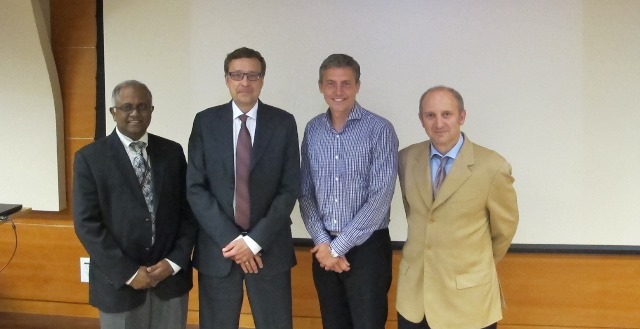
Excellence in Mentoring Award winners (l to r): Lalith Satkunam, Richard Fedorak, Jason Dyck, Larry Fliegel
How did Lalith Satkunam become a great mentor? He overcame his own fears.
"Many years ago, teaching was a phobia for me," remembers Satkunam, a professor in the Division of Physical Medicine & Rehabilitation and an international expert in spasticity. "I did not want to be a teacher. I had a fear of what I did not know, a fear of embarrassment, of standing in front of a group and saying I don't know." But to his surprise, his very first teaching experience at the University of Saskatchewan in 1990 brought the discovery that he had a talent for connecting with students.
Fast forward to 2013 where Satkunam is the winner of the Faculty of Medicine & Dentistry's Tier II award for clinical mentoring. In the years since his first revelation about teaching, Satkunam has spent some time developing his personal teaching and mentoring philosophy. "For me, the most important thing is to come down to the level of the students to connect with them, rather than take a hierarchical approach that 'I am the teacher and you are the student,'" says Satkunam, adding that hierarchy was the order of the day when he went through medical school. "Mentoring is a two-way street to me. I learn from the students as much as they learn from me."
Elizabeth Condliffe can attest to the truth of that statement. The physical medicine and rehabilitation resident was mentored by Satkunam and tells how she once challenged him on the definition of spasticity he was using as perhaps less inclusive than it should be. They debated it in class and he argued convincingly for the simpler definition. But six months later he sought Elizabeth out to tell her he had changed his mind and now used the more comprehensive definition she had suggested. "The funny thing is that I never would have known about the new definition if not for Lalith," she adds, explaining that it was his guidance and education on spasticity that led her to the definition in her reading. Condliffe is now taking a break from her residency to do a PhD and Satkunam is on her supervisory committee, still bringing his expertise and enthusiasm to help guide her career.
In fact, Satkunam credits the development of his two-way approach to mentoring to curing his phobia of teaching. "Now I am more than happy to stand up and say I don't know something and more than happy to learn from a student who can teach me something. In fact, I push them to teach me." He proudly points out that two people he once mentored, Nigel Ashworth and Shaun Gray, both went on to head the U of A Division of Physical Medicine & Rehabilitation, and thus become Satkunam's bosses.
"My take home message is to freely share your experiences both as mentee and mentor," says Satkunam. "And that it is important for every physician, not just academic physicians, to mentor the next generation of doctors as part of our ongoing commitment such that our patients will continue to receive quality care even after us."
Lalith Satkunam is one of four recipients of the Faculty's Excellence in Mentoring Awards for 2013. Larry Fliegel and Jason Dyck received awards for mentoring in basic science and Richard Fedorak was also honoured for clinical mentoring. All four recipients of the Excellence in Mentoring Awards were honoured at a reception hosted by the Faculty on June 17 to celebrate their major contributions in advancing health through teaching our future scientists and clinicians about excellence in research and patient care. Samuel Cheung, winner of the graduate student teaching award for the FoMD, was also recognized at the event.